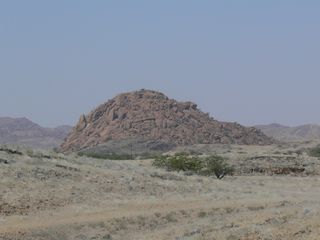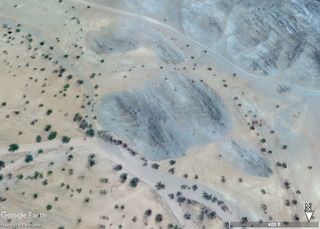Photos: Traces of an Ancient Ice Stream
Finding eroded hills

West Virginia University geologists Graham Andrews (shown in picture) and Sarah Brown, discovered glacier-eroded hills called drumlins, and their larger counterparts whalebacks and megawhalebacks while journeying through northern Namibia.
Measuring the structures

West Virginia University senior Andrew McGrady then used morphometrics, or measurements of shapes to figure out if these structures could have been carved by ice streams.
A map of Namibia

By analyzing the area using Google Earth, the researchers found that there were around a hundred or so of these drumlins and whalebacks sprinkled around the area of Twyfelfontein in Namibia.
A drumlin

Here is one of six or seven drumlins that the researchers found on their trip to Namibia.
A drumlin

These drumlins were crafted by ice streams that flowed over the area around 300 million years ago. Between now and then, hundreds of thousands of rocks covered the structures — and then eventually eroded again, re-exposing them.
A drumlin

These drumlins haven't been documented before.
A megawhaleback

Similarly, megawhalebacks are hills eroded by ice streams, but when seen from above, they are longer and more elliptical in shape than drumlins.
Sign up for the Live Science daily newsletter now
Get the world’s most fascinating discoveries delivered straight to your inbox.
A megawhaleback

By looking at the location and orientation of these megawhalebacks, the team concluded that the ice stream likely flowed toward the northwest into shallow waters in modern-day Brazil. Their findings further confirm that southern Africa was joined with South America and sat over the South Pole during this late Paleozoic age.
A megawhaleback

This zoomed-in photo shows grooves carved into the bedrock by the ancient ice stream in Namibia.

Yasemin is a staff writer at Live Science, covering health, neuroscience and biology. Her work has appeared in Scientific American, Science and the San Jose Mercury News. She has a bachelor's degree in biomedical engineering from the University of Connecticut and a graduate certificate in science communication from the University of California, Santa Cruz.

380 million-year-old remains of giant fish found in Australia. Its 'living fossil' descendant, the coelacanth, is still alive today.

New memory chip controlled by light and magnets could one day make AI computing less power-hungry

Northern sea robin: The bizarre fish with crab legs it uses to taste the seafloor